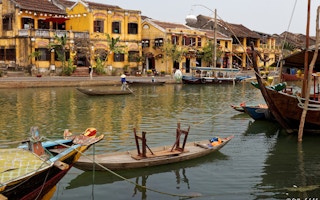Let’s talk about smart cities in Asia and the Pacific, where much progress has been made in recent years. Yokohama City established in 2011 its Y-Port center as a platform to share its experiences on applying smart city concepts in the city’s development, while India launched its 100 Smart Cities Program in 2015, and so on.
To continue reading, subscribe to Eco‑Business.
There's something for everyone. We offer a range of subscription plans.
- Access our stories and receive our Insights Weekly newsletter with the free EB Member plan.
- Unlock unlimited access to our content and archive with EB Circle.
- Publish your content with EB Premium.
However, these recent initiatives are actually anchored on the Western concept of smart cities —which gives huge importance to the use of electronic networks and the internet to help in, as the Canadian Federal Government has said, in “forming alliances and partnerships in order to innovate and extract new economic and social values.”
This and other western definitions of smart cities could well hinder Asia’s secondary cities from attaining smart city status if they rely on heavy investments in information and communications technology or ICT.
In Asia, when it comes to the smart cities race we can expect cities from Japan and the Republic of Korea, as well as Hong Kong and Singapore, to be at par with the West given their resources and human resource capacity.
But what if we’re talking about Battambang in Cambodia, Tacurong in the Philippines, Dong Ha in Viet Nam, and many other booming secondary cities whose name you may never have even heard? If investments in ICT are a prerequisite to attaining smart city status, then almost all of cities and towns in developing Asia will definitely be left out.
This is pertinent because according to UN Habitat, as of 2015 about 47% of the Asia’s urban residents live in secondary cities, with a population of less than 500,000. This gives the impression that if we are talking about inclusive urban growth in Asia, we should focus on where many urban dwellers reside.
Why do cities want to become technologically smart? Simply put, this should mean services are efficiently delivered, which translates into economic and social benefits for the city. It is therefore like a status symbol. But, in fact, when it comes to delivering efficient services, there are other and more important prerequisites common to all cities and towns: (i) realistic governance and institutional policy frameworks; (ii) efficient management and monitoring systems; and (iii) a strong human resource base.
So from this perspective, is it necessary for secondary cities and towns in Asia to become smart cities given their limited resources compared to major cities? Or are there other ways of being smart even without much resources to invest on ICT?
“
If investments in ICT are a prerequisite to attaining smart city status, then almost all of cities and towns in developing Asia will definitely be left out.
Let’s take the case of the relatively small town of Hoi An in Viet Nam. Strict policies prohibiting four-wheeled vehicles from traversing the old quarter and only allowing non-motorized transport in the evening, combined with building regulations that help maintain the traditional urban fabric, have made the town a must-see tourist destination in Viet Nam.
Not much investment in ICT was made for management and monitoring, but with a flourishing tourism industry, the town had an opportunity to showcase its handicrafts, skills and food, which in turn translated into employment and business opportunities and other social benefits for its citizens. This case shows that playing to one’s own strengths and backed up by an enabling policy framework that is strictly enforced, a secondary town can still become ‘smart’.
Hoi An, we could say, has achieved “culturally-smart city status that has translated into social and economic gains for the town and its surrounding communities.
Hoi An’s experience demonstrates that attaining smart city status for secondary cities is possible even with limited ICT investments. A quite similar case is being started in Yogyakarta, Indonesia. The city was able to forge a partnership with a large ICT company for its ‘culture-based’ smart city program aimed at integrating the cultural characteristics of the city into its development thrusts.
Through this partnership, ICT systems will be integrated into the municipal management system to boost sectors like education, as Yogyakarta hosts the main campus of Gadjah Mada University, Indonesia’s top university), tourism, environmental/disaster management, and even funeral administration. The rationale is again to build on Yogyakarta’s strengths and competitive advantage —education and cultural tourism—to showcases its unique urban character.
These two examples show that ICT is not a prerequisite but rather a facilitator of management and development processes that make cities smarter and bring economic and social benefits. This concept of smart city is a much better fit for Asia, considering the level of development of secondary cities.
If Asian cities are be able to embrace this simpler definition of smart city, then the region’s secondary cities will not be left out of the smart cities race.
Aldrin Plaza is urban development officer, Sustainable Development and Climate Change Department, Asian Development Bank. This post is repubished from the ADB Blog.











